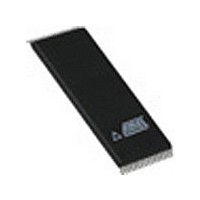AT49LV002-70VC Atmel, AT49LV002-70VC Datasheet - Page 3

AT49LV002-70VC
Manufacturer Part Number
AT49LV002-70VC
Description
Manufacturer
Atmel
Datasheet
1.AT49LV002-70VC.pdf
(26 pages)
Specifications of AT49LV002-70VC
Cell Type
NOR
Density
2Mb
Access Time (max)
70ns
Interface Type
Parallel
Boot Type
Bottom
Address Bus
18b
Operating Supply Voltage (typ)
3.3V
Operating Temp Range
0C to 70C
Package Type
TSOP
Program/erase Volt (typ)
3 to 3.6V
Sync/async
Asynchronous
Operating Temperature Classification
Commercial
Operating Supply Voltage (min)
3V
Operating Supply Voltage (max)
3.6V
Word Size
8b
Number Of Words
256K
Supply Current
25mA
Mounting
Surface Mount
Pin Count
32
Lead Free Status / Rohs Status
Not Compliant
Device
Operation
0982D–FLASH–02/03
READ: The AT49BV/LV002(N)(T) is accessed like an EPROM. When CE and OE are low and
WE is high, the data stored at the memory location determined by the address pins is asserted
on the outputs. The outputs are put in the high impedance state whenever CE or OE is high.
This dual-line control gives designers flexibility in preventing bus contention.
COMMAND SEQUENCES: When the device is first powered on it will be reset to the read or
standby mode depending upon the state of the control line inputs. In order to perform other
device functions, a series of command sequences are entered into the device. The command
sequences are shown in the Command Definitions table. The command sequences are written
by applying a low pulse on the WE or CE input with CE or WE low (respectively) and OE high.
The address is latched on the falling edge of CE or WE, whichever occurs last. The data is
latched by the first rising edge of CE or WE. Standard microprocessor write timings are used.
The address locations used in the command sequences are not affected by entering the com-
mand sequences.
RESET: A RESET input pin is provided to ease some system applications. When RESET is at
a logic high level, the device is in its standard operating mode. A low level on the RESET input
halts the present device operation and puts the outputs of the device in a high impedance
state. If the RESET pin makes a high to low transition during a program or erase operation, the
operation may not be successfully completed and the operation will have to be repeated after
a high level is applied to the RESET pin. When a high level is reasserted on the RESET pin,
the device returns to the read or standby mode, depending upon the state of the control inputs.
By applying a 12V ± 0.5V input signal to the RESET pin, the boot block array can be repro-
grammed even if the boot block lockout feature has been enabled (see Boot Block
Programming Lockout Override section). The RESET feature is not available on the
AT49BV/LV002N(T).
ERASURE: Before a byte can be reprogrammed, the main memory block or parameter block
which contains the byte must be erased. The erased state of the memory bits is a logical “1”.
The entire device can be erased at one time by using a 6-byte software code. The software
chip erase code consists of 6-byte load commands to specific address locations with a specific
data pattern (please refer to the Chip Erase Cycle Waveforms).
After the software chip erase has been initiated, the device will internally time the erase opera-
tion so that no external clocks are required. The maximum time needed to erase the whole
chip is t
not be erased.
CHIP ERASE: If the boot block lockout has been enabled, the Chip Erase function will erase
Parameter Block 1, Parameter Block 2, Main Memory Block 1, and Main Memory Block 2 but
not the boot block. If the Boot Block Lockout has not been enabled, the Chip Erase function
will erase the entire chip. After the full chip erase the device will return back to read mode. Any
command during chip erase will be ignored.
SECTOR ERASE: As an alternative to a full chip erase, the device is organized into sectors
that can be individually erased. There are two 8K-byte parameter block sections and two main
memory blocks. The 8K-byte parameter block sections can be independently erased and
reprogrammed. The two main memory sections are designed to be used as alternative mem-
ory sectors. That is, whenever one of the blocks has been erased and reprogrammed, the
other block should be erased and reprogrammed before the first block is again erased. The
Sector Erase command is a six bus cycle operation. The sector address is latched on the fall-
ing WE edge of the sixth cycle while the 30H data input command is latched at the rising edge
of WE. The sector erase starts after the rising edge of WE of the sixth cycle. The erase opera-
tion is internally controlled; it will automatically time to completion.
EC
. If the boot block lockout feature has been enabled, the data in the boot sector will
AT49BV/LV002(N)(T)
3
















